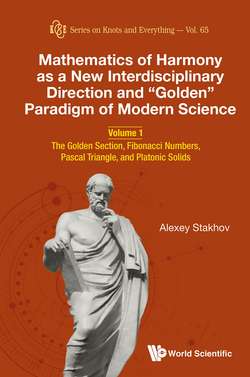Читать книгу Mathematics of Harmony as a New Interdisciplinary Direction and “Golden” Paradigm of Modern Science - Alexey Stakhov - Страница 28
На сайте Литреса книга снята с продажи.
1.2.4. The origin of the term of the golden section
ОглавлениеThe approximate value of the golden proportion is the following:
Do not be surprised by this number! Do not forget that this number is irrational! In our book, we will use the following approximate value of Φ: Φ ≈ 1.618 or even Φ ≈ 1.62.
It is this amazing number, possessing unique algebraic and geometric properties, that has become an aesthetic canon of ancient Greek and Renaissance arts.
Who introduced the term golden section? Sometimes, the introduction of this name (“section aurea”) is attributed to Leonardo da Vinci. However, there is an opinion that the great Leonardo was not the first. According to the statement of Edward Soroko [4], this term goes back to Ptolemy’s book About Harmony. However, in the book [32] on the history of the “golden number”, it is stated that the German mathematician Martin Om first introduced the term “goldener Schnitt” in 1835 in the book Die reine elementar mathematik.
The designation of the golden proportion by the Greek letter Φ (the number Φ) is not accidental. This letter is the first letter in the Greek name of the famous Greek sculptor Phidias (Greek: Φειδας), who widely used the golden section in his sculptural works. Recall that Phidias (480–430 BC) was one of the most significant and authoritative masters of ancient Greek sculpture of the classics era (Fig. 1.6).
As a sculptor, he became famous for having created two grandiose (gold and ivory) statues: Athens Parthenos for the Parthenon at the Acropolis (446–438 BC) and Olympus Zeus (for the Temple of Zeus at Olympia, circa 430 BC), which were considered as one of the “Seven Wonders of the World”. For all the monumentality of these sculptures, unprecedented in size for Greece of that time, they were characterized by a strict balance and harmony of plastic contrasts, based on the golden section, which was the essence of the classical style in the period when it was flourishing the highest.
Fig. 1.7. The method of geometric construction of the golden section.
The essence of the method in Fig. 1.7 is as follows. We construct the right-angular triangle ABC with the sides AB = 1, AC = . Then, in accordance with the “Pythagoras theorem”, we calculate the side CB = Drawing the arc AD with the center at the point C before the intersection with the segment CB at the point D, we obtain the segment BD = CB − CD = = Φ−1. By drawing the arc BD with the center at the point B before its intersection with the segment AB at the point E, we obtain the division of the segment AB at the point E with the golden section, because
